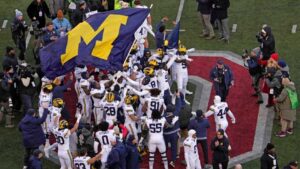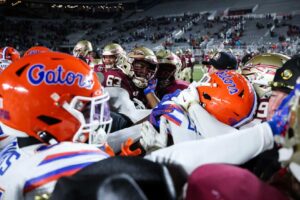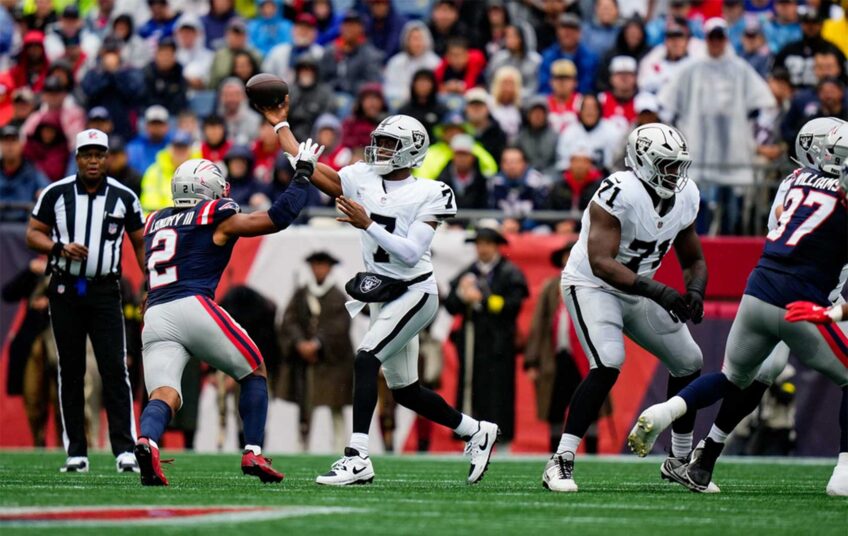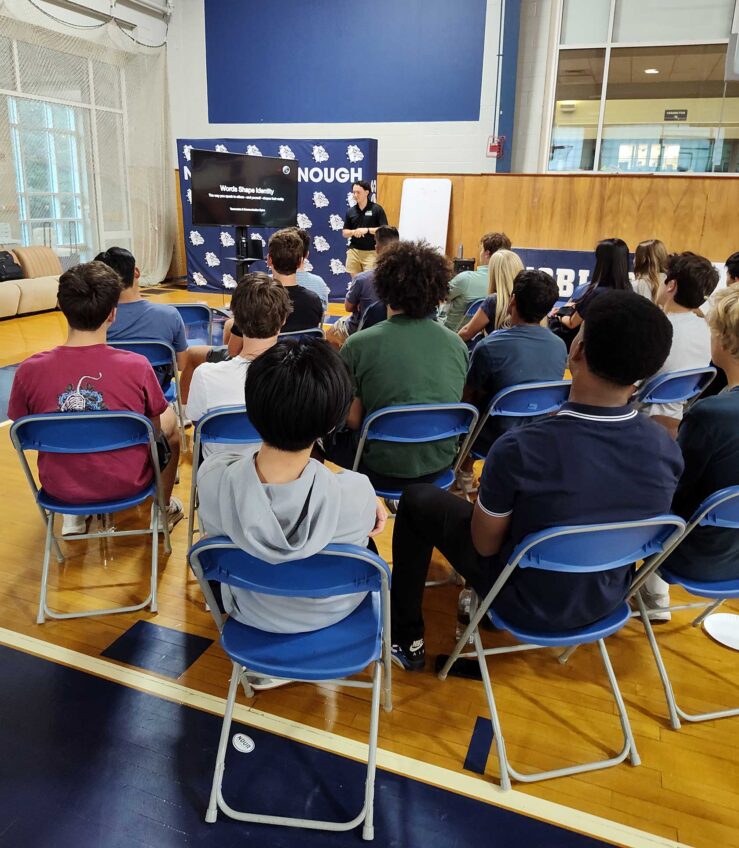Post game riots rock college football rivalries
Multiple teams fined but no suspensions for players involved in numerous post game fights
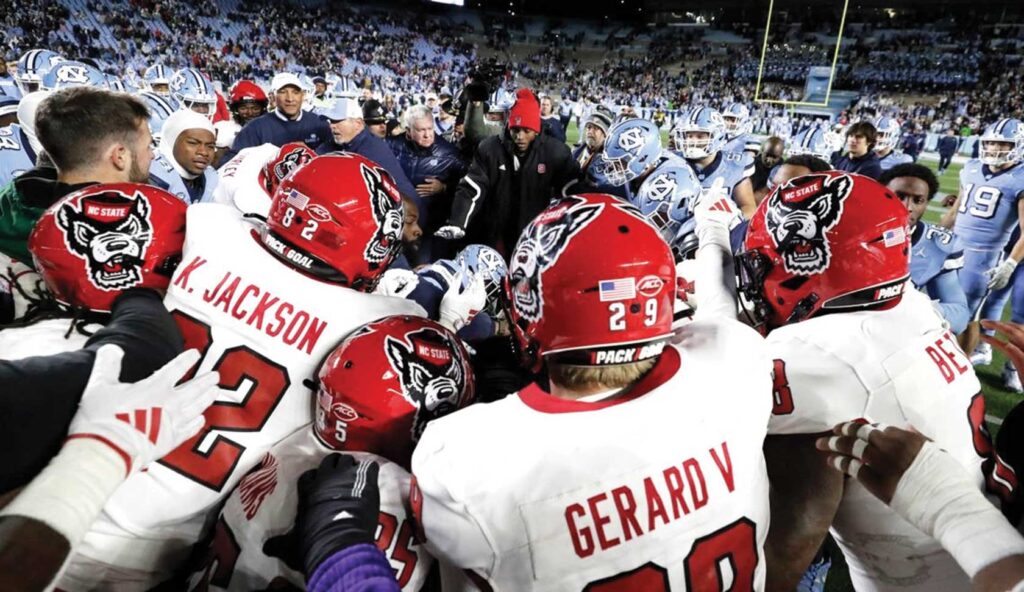
Banner Sports Sponsored by the Patriots Foundation
What is it about rivalries in sports that bring out the absolute worst behavior in fans? Sociologists and psychiatrists have been wrestling with that question for centuries, and many of the most brilliant minds in those fields have yet to find answers. The latest chapter of what this reporter will call “rivalry rioting” occurred this past weekend at four different college football games.
The first rivalry riot occurred in Columbus, Ohio, following the 122nd playing of the game between the Wolverines of Michigan and the Buckeyes of Ohio State, two of the more prestigious universities and elite powers of the college gridiron sect.
Having covered this game for the better part of 50 years, I can say without reservation that the bad blood between the Wolverines and Buckeyes fans is real. Just ask any of the alums from either school. They will verify the intensity of the matchup. After hearing the voices of the hundreds of fans interviewed over decades, the battle cry has been the same: “Beat Ohio State” or “Beat Michigan,” depending on which team you root for, or your entire season is a failure.
Going into Saturday’s game, Ohio State ranked No. 2 in the national college football standings and was the overwhelming favorite. The so-called experts of college football figured they would roll over Michigan and end their current three-game losing streak against the maize in blue. But when the smoke cleared, it was Michigan, 13, Ohio State, 10, in what has been described as one of the greatest upsets in college football history.
Since the modern glory days of Ohio State’s Woody Hayes and Bo Schembechler’s Michigan squads in the late 1960s and ’70s, there have been periods of domination by both teams. History shows that Michigan holds a 62-51-6 advantage in the overall series, which began in 1897, with the Wolverines winning 13 of the first 15 games. The other two contests ended in ties.
Winning for the first time in 1919, Ohio State has dominated the series, winning from 2004 to 2010 and from 2012 to 2019.
The scenario took an absurd turn for worse when the clock struck zero on the 2024 event. Michigan players tried to plant their flag in the middle of the ceremonial “Big O” at midfield of Buckeye Stadium. A melee of significant proportions followed, as both teams exchanged violent blows before a national television audience.
Police in large, forceful numbers stormed the field to put down the uprising. Those words are not hyperbole; they accurately describe the all-out violence that took place on the field. Police officers used volumes of pepper spray to restore order. For the record, the Michigan flag was not planted on the Big O.
Both schools were fined $100,000 for the incident, but the bigger story is that no players were suspended for their actions in the melee. Since Michigan and Ohio State will head to post-season bowls games, a fine with no player suspensions is good enough.
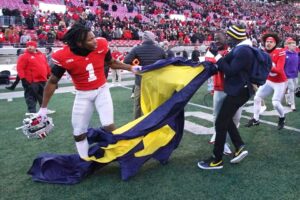
OSU running back Quinshon Judkins tries to take Michigan flag from Michigan alum Jason Avanat. PHOTO: ADAM KING/NCAA
The Buckeyes are close to locking up a spot in the final 12 for the NCAA Division 1 National Championship. Postgame antics are neither an appropriate solution to this ongoing problem, nor a deterrent for future violent outbreaks. Players, coaches and all who play a part in this team-sport scenario must be held accountable for their actions.
When people try to say that this is what rivalry is all about and that going to battle against your enemy school may lead to this behavior, this is a narrow-minded view. A football game or any other sporting event is not a war. It’s just an athletic event.
Michigan and Ohio State were not the only schools to act out following rivalry games. Tensions flared with a pitchfork incident after the Arizona/Arizona State’s Territorial Cup game. An Arizona State player attempted to stab the ceremonial pitchfork of his school into the “A” logo at Wildcat Stadium following his Sun Devil team’s 49-7 rout of the home team Wildcats. A brawl started shortly after that, with players from both teams involved in the dust-up. Ironically, the ASU player who stabbed the turf, Jacob Rich Kongaika, used to play for Arizona in 2022 and 2023.
There were also postgame incidents at the Florida/Florida State and North Carolina/ North Carolina State interstate contests. University of Florida players tried to plant their school flag at the center of the Seminoles’ field following their lopsided victory over their archrival. FSU players, who witnessed a flaming spear ceremony before home games — an indignation to many Native Americans — took offense to Florida players planting their Gator flag on their field. The U.F. flag was unplanted and ripped to pieces. It did not fly for more than a few seconds, during which punches were thrown, and the teams were separated. Authorities finally stepped in and restored order.
Not to be outdone, the Atlantic Coast Conference had its fight controversy as rivals North Carolina and North Carolina State squared off following the Wolfpack’s 35-30 triumph in Chapel Hill. Predictable violence erupted when N. C. State players defiled the Tar Heels logo during their postgame celebration. One Tar Heel player threw the Wolfpack flag into the stands after the un-celebration. More flag ripping and shredding ensued before police, school and other security officials restored order.
These are just four of the latest examples of how fans and players of teams get totally out of control at a rivalry game. Forget trying to make sense of it all. Fighting is now the modern way of dealing with the passions of a contest between two schools. It is not the way to compete.
More substantial police or security presence at such games, regardless of the sport, is desperately needed to stem the tide of rage that overtakes the clear-thinking of ordinarily decent people.
Rivalry is a part of sports, but the violence associated with it is not needed or desired.

